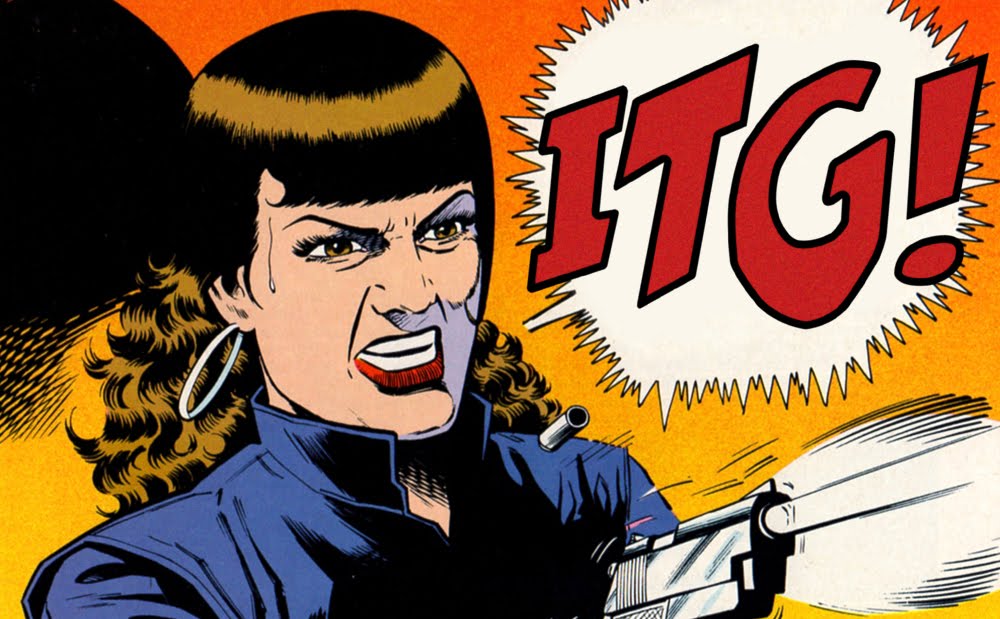The story in this issue would be Steve Savage's last lead feature. He hadn't appeared since issue 114 - #115 featured longtime
AAMoW star Johnny Cloud, The Navajo Ace, and the next issue, #117, also featuring Cloud, would be the title's last.
This issue's cover sports another sensational Joe Kubert drawing, though the cover does continue a trend of inconsistent hair color for The Balloon Buster - he's been variously a blonde, a red head, and for this one & only time, a raven-haired saddle tramp. Returning to illustrate this Robert Kanigher story is original strip artist, Russ Heath - and Heath delivers his finest work on the character.
This wartime thriller opens up with a visit to the base by the major's beautiful daughter, Constance. She's immediately drawn to Steve Savage, so her father offers a word of warning - Savage is nothing but T-R-O-U-B-L-E! After the major 'conveniently' forgets to introduce his daughter to the man he
hates the most, Constance boldly takes the initiative and sidles up to our saddle tramp - just as a squadron of German Fokkers strafe the airfield.
 |
| Russ Heath's return to The Balloon Buster starts of with a BANG! |
Not one to take an attack like this lying down, Savage jumps into action, quickly taking his plane up to confront the assailants. He manages to take out a couple of planes, but runs into trouble with this issue's German ace - The Executioner. Savage takes some heavy fire from the Executioner, and is forced to do the unthinkable - to survive he must abandon ship! As his plane plummets to the earth, Savage survives a desperate jump from the aircraft into a nearby lake. So Round 1 of this dogfightgoes to the Executioner - but as they say, payback (and The Balloon Buster)'s a bitch!
 |
| Steve Savage seems to spend more time on the outside of his plane than in the cockpit! |
At a dance the following evening, Savage overhears a conversation between Constance and a friend. The major's daughter intends to 'tame the wild animal' that is Steve Savage. To teach her a bit of a lesson, he becomes a little forward after one of their dances - which immediately puts the girl off, and in her mind, confirms her father's assessment of the Balloon Buster's 'character.' After exiting the party, Savage overhears a report of an imminent German raid.
 |
| The un-tame-able Savage proves a point |
Because that's how he does it, Savage steals the major's plane & puts the kibosh on the German bombing. He lands outside a local bar - where he promptly defends the honor of an abused barmaid named Mimi. Finding some kinship in their shared poverty-stricken background, Savage can't help but fulfill Mimi's dream to fly.
 |
| I refuse to go with the obvious 'Is that the plane's stick in your
pocket . . . ' joke, but I will say that I cringe a little at the bad
phonetic French accent, every time I read it in a comic |
This turns out to be a very bad idea, as the duo is immediately attacked by The Executioner and a couple of his cronies. They take some fire, Mimi taking the brunt of it, and return some, shooting down The Executioner's wingmen. With the final enemy aircraft in hot pursuit, and no way to get his front-facing machine guns turned around on his target, Savage performs yet another unthinkable act - he climbs out on the plane's fuselage and starts shooting at the Executioner with his side arm! And as he chantshis mantra '
I'm Th' Gun!' for what may be the last time in print, he actually manages to send the German ace to a fiery demise!
 |
| Again with the outside the cockpit action! |
This action comes at a horrible price, however, as when Savage lands his plane, he discovers that the shots suffered by Mimi were fatal - The Balloon Buster's 'touch of death' reached not only for the enemy, but an ally, as well.
This is the last time that Steve Savage would be the lead feature in a comic. The last panel promises more Steve Savage soon, but it was not to be. I don't know the circumstances surrounding the cancellation of
All-American Men of War, or whether or not there were further adventures of The Balloon Buster planned, but I have to assume that if the book sold well, if the character sold well - it wouldn't have gotten cancelled. The four stories in
AAMoW were exciting (if a little formulaic), classic war stories, featuring a pretty unique character, and you couldn't ask for a better creative team on this type a story than Kanigher/Heath/Kubert.
And there WOULD be more Balloon Buster - within the next 10 to 15 years, there would be back-up (co-back-up, really) stints in
Star-Spangled War Stories and
The Unknown Soldier where Steve Savage would finally meet his match in the ultimate German ace, Hans Von Hammer, The Enemy Ace. I can't wait to get to these stories in future posts!






































